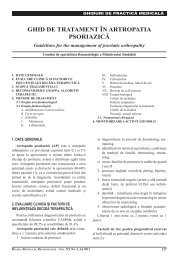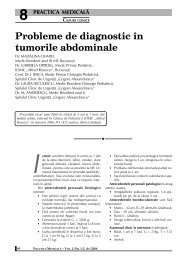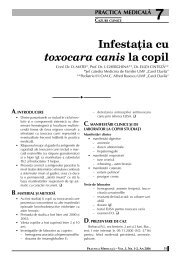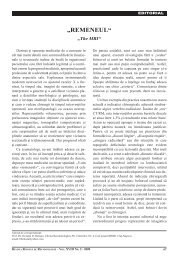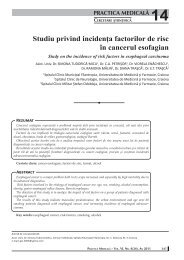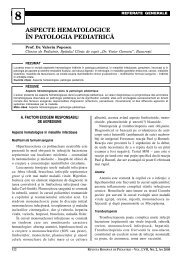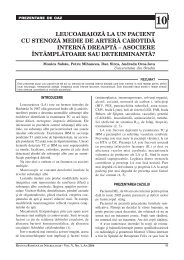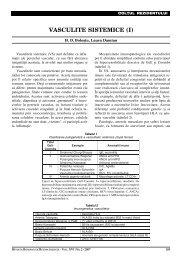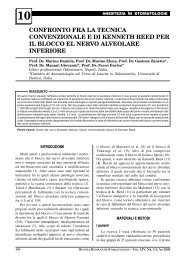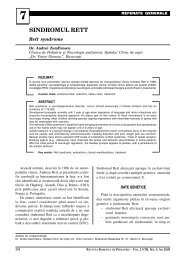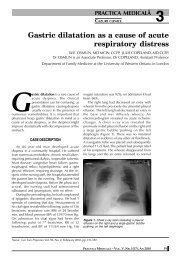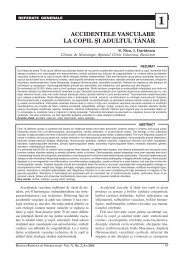abnormal uterine bleeding and dysfunctional uterine ... - medica.ro
abnormal uterine bleeding and dysfunctional uterine ... - medica.ro
abnormal uterine bleeding and dysfunctional uterine ... - medica.ro
Create successful ePaper yourself
Turn your PDF publications into a flip-book with our unique Google optimized e-Paper software.
2<br />
EDUCAŢIE MEDICALĂ CONTINUĂ<br />
ABNORMAL UTERINE BLEEDING AND<br />
DYSFUNCTIONAL UTERINE BLEEDING<br />
IN ADOLESCENCE: DIAGNOSIS, MANAGEMENT<br />
AND TREATMENT<br />
E. Deligeo<strong>ro</strong>glou, MD, PhD; V. Ka<strong>ro</strong>untzos, MD, G. Creatsas, MD<br />
Division of Pediatric – Adolescent Gynecology <st<strong>ro</strong>ng>and</st<strong>ro</strong>ng> Reconstructive Surgery,<br />
2nd Department of Obstetrics <st<strong>ro</strong>ng>and</st<strong>ro</strong>ng> Gynecology, University of Athens,<br />
Medical School, “Aretaieion” Hospital, Athens, Greece<br />
ABSTRACT<br />
Abnormal Uterine Bleeding (AUB) is a common cause for concern among adolescents <st<strong>ro</strong>ng>and</st<strong>ro</strong>ng> their families, as well as a<br />
frequent cause of visits to the Emergency Department <st<strong>ro</strong>ng>and</st<strong>ro</strong>ng>/or health care p<strong>ro</strong>vider. (1) While there are many etiologies<br />
of AUB, the one most likely among otherwise healthy adolescents is Dysfunctional Uterine Bleeding (DUB).<br />
Key words: <st<strong>ro</strong>ng>abnormal</st<strong>ro</strong>ng> <st<strong>ro</strong>ng>uterine</st<strong>ro</strong>ng> <st<strong>ro</strong>ng>bleeding</st<strong>ro</strong>ng>; <st<strong>ro</strong>ng>dysfunctional</st<strong>ro</strong>ng> <st<strong>ro</strong>ng>uterine</st<strong>ro</strong>ng> <st<strong>ro</strong>ng>bleeding</st<strong>ro</strong>ng>; adolescence;<br />
menstrual disorders<br />
INTRODUCTION<br />
Abnormal Uterine Bleeding (AUB) is a common<br />
cause for concern among adolescents <st<strong>ro</strong>ng>and</st<strong>ro</strong>ng> their families,<br />
as well as a frequent cause of visits to the<br />
Emergency Department <st<strong>ro</strong>ng>and</st<strong>ro</strong>ng>/or health care p<strong>ro</strong>vider.<br />
(1) While there are many etiologies of AUB, the one<br />
most likely among otherwise healthy adolescents is<br />
Dysfunctional Uterine Bleeding (DUB). This is due<br />
to the immaturity of the Hypothalamic-Pituitary-<br />
Ovarian (HPO) axis, which results in anovulatory<br />
cycles & unpredictable <st<strong>ro</strong>ng>bleeding</st<strong>ro</strong>ng>. Dysfunctional Uterine<br />
Bleeding describes the spectrum of <st<strong>ro</strong>ng>abnormal</st<strong>ro</strong>ng><br />
menstrual <st<strong>ro</strong>ng>bleeding</st<strong>ro</strong>ng> patterns that may occur in adolescent<br />
girls who have no <st<strong>ro</strong>ng>medica</st<strong>ro</strong>ng>l illness or pelvic<br />
pathology. (2) DUB is characterizing any <st<strong>ro</strong>ng>abnormal</st<strong>ro</strong>ng><br />
<st<strong>ro</strong>ng>uterine</st<strong>ro</strong>ng> <st<strong>ro</strong>ng>bleeding</st<strong>ro</strong>ng> when all possible underlying pathologic<br />
causes have been previously excluded.<br />
NORMAL MENSTRUAL CYCLE & ABNORMAL<br />
BLEEDING<br />
In the vast majority of females, menarche occurs<br />
two or three years after thelarche. (3) The mean age<br />
of menarche varies with ethnicity: 12.7 years for<br />
non-Hispanic white girls, 12.3 years for black girls,<br />
& 12.5 years for Mexican American girls (4). Many<br />
adolescents may report “irregular” periods for 2 to<br />
3 years after menarche due to anovulatory cycles<br />
<st<strong>ro</strong>ng>and</st<strong>ro</strong>ng> an immature Hypothalamic-Pituitary-Ovarian<br />
axis. (5,6) Once a “regular” menstruating pattern is<br />
established, the cycle is characterized by periodicity<br />
<st<strong>ro</strong>ng>and</st<strong>ro</strong>ng> ranges between 21 <st<strong>ro</strong>ng>and</st<strong>ro</strong>ng> 40 days, with <st<strong>ro</strong>ng>bleeding</st<strong>ro</strong>ng><br />
usually lasting 2 to 7 days <st<strong>ro</strong>ng>and</st<strong>ro</strong>ng> an average blood<br />
loss of 20 to 80 mL. (7)<br />
Abnormal <st<strong>ro</strong>ng>bleeding</st<strong>ro</strong>ng> may present as:<br />
1. Menorrhagia, defined as <st<strong>ro</strong>ng>bleeding</st<strong>ro</strong>ng> that lasts<br />
more than 7 consecutive days or by more<br />
than 80 mL of blood loss but still occuring at<br />
regular intervals.<br />
2. Met<strong>ro</strong>rrhagia defined as <st<strong>ro</strong>ng>bleeding</st<strong>ro</strong>ng> that occurs<br />
at irregular intervals.<br />
3. Menomet<strong>ro</strong>rrhagia characterized by heavy<br />
irregular <st<strong>ro</strong>ng>bleeding</st<strong>ro</strong>ng>.<br />
If the interval of menstrual cycle is between 41<br />
days <st<strong>ro</strong>ng>and</st<strong>ro</strong>ng> 3 months, this is considered to be oligomenorrhea.<br />
(8)<br />
As mentioned before, DUB is defined as <st<strong>ro</strong>ng>abnormal</st<strong>ro</strong>ng><br />
apoptosis of the endometrium in the absence of<br />
a structural or <st<strong>ro</strong>ng>medica</st<strong>ro</strong>ng>l <st<strong>ro</strong>ng>abnormal</st<strong>ro</strong>ng>ity <st<strong>ro</strong>ng>and</st<strong>ro</strong>ng> is most<br />
often due to anovulation. (5,7) Although underlying<br />
pathology is recognized in less than 10% of abnor-<br />
Adresa de corespondenţă:<br />
E. Deligeo<strong>ro</strong>glou, MD, PhD., Medical School, “Aretaieion” Hospital, Athens, Greece<br />
e-mail: deligeo<strong>ro</strong>glou@yahoo.gr<br />
272<br />
REVISTA MEDICALÅ ROMÂNÅ – VOLUMUL LIX, NR. 4, An 2012
REVISTA MEDICALÅ ROMÂNÅ – VOLUMUL LIX, NR. 4, An 2012 273<br />
mal <st<strong>ro</strong>ng>bleeding</st<strong>ro</strong>ng>, DUB is a diagnosis of exclusion, <st<strong>ro</strong>ng>and</st<strong>ro</strong>ng><br />
other causes must be ruled out (7). In the United<br />
States of America (USA) the definition of DUB<br />
refers to anovulatory <st<strong>ro</strong>ng>bleeding</st<strong>ro</strong>ng>. (9) On the other<br />
h<st<strong>ro</strong>ng>and</st<strong>ro</strong>ng>, the Eu<strong>ro</strong>pean Society of Human Rep<strong>ro</strong>duction<br />
<st<strong>ro</strong>ng>and</st<strong>ro</strong>ng> Embryology (ESHRE) defined DUB as excessive<br />
<st<strong>ro</strong>ng>bleeding</st<strong>ro</strong>ng> (excessively heavy, p<strong>ro</strong>longed or<br />
frequent) of <st<strong>ro</strong>ng>uterine</st<strong>ro</strong>ng> origin, which is not caused by<br />
demonstrable pelvic disease, complication of pregnancy<br />
or systemic disease. According to this definition<br />
by ESHRE, DUB can be either ovulatory or<br />
unovulatory. (10)<br />
PATHOPHYSIOLOGY & DIFFERENTIAL<br />
DIAGNOSIS OF DUB<br />
The pathophysiology of DUB is not well established.<br />
In anovulatory DUB, the positive “feedback”<br />
of estradiol (E2) to luteinizing hormone (LH)<br />
is not working p<strong>ro</strong>perly, making menstrual cycles<br />
monophasic <st<strong>ro</strong>ng>and</st<strong>ro</strong>ng> anovulatory. (11) Due to the absence<br />
of midcycle LH surge, (12) follicle atresia<br />
occurs <st<strong>ro</strong>ng>and</st<strong>ro</strong>ng> become cystic, p<strong>ro</strong>ducing only est<strong>ro</strong>gens<br />
but not p<strong>ro</strong>geste<strong>ro</strong>ne. (13) During these anovulatory<br />
cycles, unopposed est<strong>ro</strong>gens, which are p<strong>ro</strong>ducts of<br />
ovarian follicles <st<strong>ro</strong>ng>and</st<strong>ro</strong>ng> of the extragonadal a<strong>ro</strong>matization<br />
of <st<strong>ro</strong>ng>and</st<strong>ro</strong>ng><strong>ro</strong>stendione, induce endometrial<br />
p<strong>ro</strong>li feration. The lack of p<strong>ro</strong>gestagenic stabilization<br />
effect, results in <st<strong>ro</strong>ng>abnormal</st<strong>ro</strong>ng> shedding of the endometrium.<br />
(14) Furthermore, the imbalance of p<strong>ro</strong>stagl<st<strong>ro</strong>ng>and</st<strong>ro</strong>ng>ins<br />
(PGs), seems to play a <strong>ro</strong>le in ovulatory<br />
DUB. During menstruation there is a balance between<br />
the vasoconstriction effect of PGF2a <st<strong>ro</strong>ng>and</st<strong>ro</strong>ng><br />
vaso dilation of PGE2 <st<strong>ro</strong>ng>and</st<strong>ro</strong>ng> PGI2 (P<strong>ro</strong>stacyclin).<br />
Circulating ste<strong>ro</strong>id levels have a great influence in<br />
endometrial PG release. An increase in total PG<br />
release <st<strong>ro</strong>ng>and</st<strong>ro</strong>ng> disp<strong>ro</strong>portional rise in PGE2 have been<br />
demonstrated in ovulatory DUB (15,16).<br />
The list of diagnoses to be considered in app<strong>ro</strong>aching<br />
the p<strong>ro</strong>blem of <st<strong>ro</strong>ng>abnormal</st<strong>ro</strong>ng> vaginal <st<strong>ro</strong>ng>bleeding</st<strong>ro</strong>ng><br />
in adolescents is long but necessitates the careful<br />
consideration <st<strong>ro</strong>ng>and</st<strong>ro</strong>ng> examination of each patient. The<br />
differential diagnosis is shown in table 1. Some<br />
causes require immediate exclusion because failure<br />
to do so may result in significant morbidity <st<strong>ro</strong>ng>and</st<strong>ro</strong>ng><br />
mor tality (17). Pregnancy-related complications<br />
for example, can present with any pattern of ab normal<br />
<st<strong>ro</strong>ng>bleeding</st<strong>ro</strong>ng> <st<strong>ro</strong>ng>and</st<strong>ro</strong>ng> among them ectopic pregnancy is<br />
one of the more serious conditions to be considered.<br />
Adolescents with pelvic inflammatory disease<br />
(PID) <st<strong>ro</strong>ng>and</st<strong>ro</strong>ng> endometritis caused by Neisseria gonorrheae<br />
or Chlamydia trachomatis frequently present<br />
with heavy or irregular <st<strong>ro</strong>ng>bleeding</st<strong>ro</strong>ng>. PID may<br />
present with vaginal <st<strong>ro</strong>ng>bleeding</st<strong>ro</strong>ng> in addition to lower<br />
abdominal pain. (17) The possibility of coagulopathy<br />
should be kept in mind, particularly in the adolescent<br />
whose menstrual history is short <st<strong>ro</strong>ng>and</st<strong>ro</strong>ng> not yet well<br />
defined. Although, the most common cause of AUB<br />
in adolescents is anovulation, more than a third<br />
may have a coagulation defect. (18,19) Bleeding<br />
dis orders are usually associated with cyclic heavy<br />
or p<strong>ro</strong>longed <st<strong>ro</strong>ng>bleeding</st<strong>ro</strong>ng> (menorrhagia). The same<br />
pattern may be observed in women receiving treatment<br />
with anticoagulants. (20) In addition, severe<br />
th<strong>ro</strong>mbocytopenia can be assessed quickly with a<br />
complete blood cell count. The possibility of an underlying<br />
<st<strong>ro</strong>ng>abnormal</st<strong>ro</strong>ng>ity is high, if an adolescent has to<br />
be hospitalized <st<strong>ro</strong>ng>and</st<strong>ro</strong>ng> her hemoglobin is less than 10<br />
g/dL. (19) Although adult women are commonly<br />
pre sented with an underlying pathology such as<br />
TABLE 1. Differential diagnosis of AUB<br />
Hematologic Pathology of the rep<strong>ro</strong>ducve tract Pregnancy Other<br />
von Willebr<st<strong>ro</strong>ng>and</st<strong>ro</strong>ng> disease Fib<strong>ro</strong>id Ectopic pregnancy Excessive exercise<br />
Th<strong>ro</strong>mbocytopenia Myoma Implantation Eating disorders<br />
Platelet dysfunction Polyp Placenta accreta Stress<br />
Coagulation defects Endometriosis Retained p<strong>ro</strong>ducts of conception Systemic disease<br />
Factor deficiencies Cervical dysplasia Threatened, spontaneous or missed Intra<st<strong>ro</strong>ng>uterine</st<strong>ro</strong>ng> Device<br />
abortion<br />
Infectious<br />
Hormonal contraceptives<br />
Cervicitis (especially Chlamydial)<br />
Endocrine Trauma Medication<br />
Hyperp<strong>ro</strong>lactinemia Sexual abuse Antipsychotics<br />
Thy<strong>ro</strong>id disorders Laceration Platelet inhibitors<br />
Adrenal disorders Foreign body Anticoagulants<br />
Polycystic ovarian<br />
synd<strong>ro</strong>me<br />
Ovarian failure<br />
Related to abortion or other surgical<br />
p<strong>ro</strong>cedure<br />
Adapted f<strong>ro</strong>m Spe<strong>ro</strong>ff, Leon; Fritz, Marc A. Title: Clinical Gynecologic Endocrinology & Infertility, 7th Edition.<br />
Copyright Β © 2005
274<br />
REVISTA MEDICALÅ ROMÂNÅ – VOLUMUL LIX, NR. 4, An 2012<br />
fib<strong>ro</strong>ids, dysplasia, or cancer, adolescents rarely<br />
pre sent with such conditions. These conditions<br />
however, are sometimes seen in young women <st<strong>ro</strong>ng>and</st<strong>ro</strong>ng><br />
should be considered during the differential diagnosis<br />
of <st<strong>ro</strong>ng>abnormal</st<strong>ro</strong>ng> <st<strong>ro</strong>ng>bleeding</st<strong>ro</strong>ng>. (17) Furthermore, a<br />
variety of different <st<strong>ro</strong>ng>medica</st<strong>ro</strong>ng>tions can predispose to<br />
<st<strong>ro</strong>ng>abnormal</st<strong>ro</strong>ng> <st<strong>ro</strong>ng>bleeding</st<strong>ro</strong>ng>, including glucocorticoids,<br />
tamoxi fen, <st<strong>ro</strong>ng>and</st<strong>ro</strong>ng> anticoagulants.<br />
MENSTRUAL HISTORY, PHYSICAL<br />
EXAMINATION & LABORATORY<br />
INVESTIGATIONS<br />
According to Vihko <st<strong>ro</strong>ng>and</st<strong>ro</strong>ng> Apter (21) the <strong>ro</strong>le of age<br />
at menarche is crucial. Specifically, the patient who is<br />
older at menarche is more likely to have a longer time<br />
of anovulatory, “irregular” cycles. The length of cycles<br />
<st<strong>ro</strong>ng>and</st<strong>ro</strong>ng> the length of <st<strong>ro</strong>ng>bleeding</st<strong>ro</strong>ng> in days, as determined by<br />
recording data on a calendar, should always be<br />
considered. It is also of great importance the number<br />
of pads or tampons used over a 24-hour period, as<br />
well as for how many days they are used. According<br />
to B<strong>ro</strong>wn (22) more than three soaked pads or six full<br />
regular-absorbency tampons per day for 3 or more<br />
days likely equates to greater than 80 mL of blood<br />
loss. The number, if any, of “regular” periods<br />
experienced by the patient <st<strong>ro</strong>ng>and</st<strong>ro</strong>ng> the history of heavy<br />
<st<strong>ro</strong>ng>bleeding</st<strong>ro</strong>ng>, clots or leaking, especially overnight<br />
(because this may be associated with a clotting<br />
disorder) should always be men tioned. (22) In addition<br />
questions should be made about the characteristics of<br />
the patient’s very first period, because a “heavy” first<br />
period may conceals a <st<strong>ro</strong>ng>bleeding</st<strong>ro</strong>ng> disorder, most<br />
commonly von Willebr<st<strong>ro</strong>ng>and</st<strong>ro</strong>ng> disease. (19,22) Finally,<br />
patient’s past <st<strong>ro</strong>ng>medica</st<strong>ro</strong>ng>l his_tory <st<strong>ro</strong>ng>and</st<strong>ro</strong>ng> family history<br />
should always be taken into consideration.<br />
Clinical examination is always very helpful <st<strong>ro</strong>ng>and</st<strong>ro</strong>ng> in<br />
a patient with p<strong>ro</strong>longed or heavy <st<strong>ro</strong>ng>bleeding</st<strong>ro</strong>ng> the<br />
evaluation should always begin with vital signs.<br />
The physician should assess the patient hemodynamically<br />
<st<strong>ro</strong>ng>and</st<strong>ro</strong>ng> look for signs of tachycardia, hypotension<br />
or orthostatic changes. Then the physical<br />
examination should p<strong>ro</strong>ceed to the genitourinary<br />
system <st<strong>ro</strong>ng>and</st<strong>ro</strong>ng> the physician should search for signs of<br />
anemia, as well as clues of other possible underlying<br />
causes, such as lacerations, vaginal discharge/<br />
inflammation or trauma. Furthermore, it is of great<br />
importance the verification that the <st<strong>ro</strong>ng>bleeding</st<strong>ro</strong>ng> is in<br />
fact f<strong>ro</strong>m the vagina/cervical origin (in sexually<br />
active women), the absence of a foreign body (e.g.,<br />
a retained tampon) <st<strong>ro</strong>ng>and</st<strong>ro</strong>ng> that the appearance of the<br />
cervix is normal. Finally, pain during bimanual<br />
palpation of the cervix, the adnexa or the uterus is<br />
indicative of possible PID. In sexually active<br />
adolescents who cannot tolerate a speculum or bimanual<br />
examination, a pelvic examination under<br />
anesthesia may need to be done. In non-sexual<br />
active adolescents recto-abdominal palpation<br />
should be carefully considered.<br />
Initial laboratory investigations should include<br />
the following:<br />
1. urine pregnancy test <st<strong>ro</strong>ng>and</st<strong>ro</strong>ng>/or quantitative<br />
serum β-HCG;<br />
2. complete blood cell count;<br />
3. pelvic ultrasound may p<strong>ro</strong>ve helpful to the<br />
diagnosis.<br />
According to B<strong>ro</strong>wn (22), in case of severe<br />
<st<strong>ro</strong>ng>bleeding</st<strong>ro</strong>ng> or when an underlying <st<strong>ro</strong>ng>bleeding</st<strong>ro</strong>ng> disorder is<br />
suspected, the following lab tests should be added:<br />
1. p<strong>ro</strong>th<strong>ro</strong>mbin time;<br />
2. partial th<strong>ro</strong>mboplastin time;<br />
3. <st<strong>ro</strong>ng>bleeding</st<strong>ro</strong>ng> time <st<strong>ro</strong>ng>and</st<strong>ro</strong>ng> platelet aggregation;<br />
4. von Willebr<st<strong>ro</strong>ng>and</st<strong>ro</strong>ng> panel, must be done prior to<br />
initiating hormonal therapy <st<strong>ro</strong>ng>and</st<strong>ro</strong>ng> coagulation<br />
factor levels/activity (depending on family<br />
history <st<strong>ro</strong>ng>and</st<strong>ro</strong>ng> ethnicity). On the other h<st<strong>ro</strong>ng>and</st<strong>ro</strong>ng>, if<br />
an endocrine disorder is suspected laboratory<br />
investigations should include:<br />
• Thy<strong>ro</strong>id Stimulating Hormone (TSH), for<br />
thy<strong>ro</strong>id disorders;<br />
• P<strong>ro</strong>lactin (PRL) levels >100 ng/mL suggest a<br />
possible pituitary adenoma;<br />
• Total <st<strong>ro</strong>ng>and</st<strong>ro</strong>ng> free Testoste<strong>ro</strong>ne (Testo, FTesto),<br />
usually elevated in polycystic ovarian<br />
synd<strong>ro</strong>me;<br />
• Dehyd<strong>ro</strong>epi<st<strong>ro</strong>ng>and</st<strong>ro</strong>ng><strong>ro</strong>ste<strong>ro</strong>ne Sulfate (DHEA-S)<br />
to assess for adrenal tumors;<br />
• LH <st<strong>ro</strong>ng>and</st<strong>ro</strong>ng> FSH, may aid in the evaluation of<br />
pituitary or ovarian function. Finally for<br />
patients in whom an infectious etiology is<br />
suspected a swab culture of the discharge <st<strong>ro</strong>ng>and</st<strong>ro</strong>ng><br />
a urethral meatus swab for gonorrhea <st<strong>ro</strong>ng>and</st<strong>ro</strong>ng><br />
chlamydia testing should be taken.<br />
MANAGEMENT<br />
Management of AUB is based on the underlying<br />
etiology <st<strong>ro</strong>ng>and</st<strong>ro</strong>ng> the severity of the <st<strong>ro</strong>ng>bleeding</st<strong>ro</strong>ng>. Primary<br />
goals are prevention of complications, such as<br />
anemia <st<strong>ro</strong>ng>and</st<strong>ro</strong>ng> reestablishment of regular cyclical<br />
<st<strong>ro</strong>ng>bleeding</st<strong>ro</strong>ng>. In case of an underlying systemic, endocrine<br />
or <st<strong>ro</strong>ng>bleeding</st<strong>ro</strong>ng> disorder, patients may require<br />
referral to the app<strong>ro</strong>priate specialists (endo crinologist,<br />
hematologist etc.) for further evaluation <st<strong>ro</strong>ng>and</st<strong>ro</strong>ng><br />
management. The management of DUB can in part<br />
be directed by the amount of flow, the degree of<br />
associated anemia, as well as patient <st<strong>ro</strong>ng>and</st<strong>ro</strong>ng> family<br />
comfort with different treatment modalities. (2,5,7)<br />
Patients’ management falls into four (4) major categories<br />
(Table 2). (23)
REVISTA MEDICALÅ ROMÂNÅ – VOLUMUL LIX, NR. 4, An 2012 275<br />
In case est<strong>ro</strong>gens are contraindicated, p<strong>ro</strong> geste<strong>ro</strong>ne<br />
only pills (10 mg) once or twice daily for 5<br />
to 10 days may p<strong>ro</strong>ve effective for light to moderate<br />
flow. Patients also may be cycled monthly on a p<strong>ro</strong>geste<strong>ro</strong>ne-only<br />
regimen. Depot med<strong>ro</strong>xyp<strong>ro</strong> ges te<strong>ro</strong>ne<br />
acetate, 150 mg intramuscularly every 3<br />
months, or Levonorgestrel intra<st<strong>ro</strong>ng>uterine</st<strong>ro</strong>ng> device<br />
(which lasts for 5 years) can also be used. However<br />
the above methods are often associated with<br />
irregular <st<strong>ro</strong>ng>bleeding</st<strong>ro</strong>ng> <st<strong>ro</strong>ng>and</st<strong>ro</strong>ng> spotting. (23)<br />
TREATMENT OF DUB<br />
Treatment options for DUB are: Compined Oral<br />
Contraceptives (COCs), P<strong>ro</strong>gestogens, Non-Ste<strong>ro</strong>idal<br />
Anti-Inflammatory Drugs (NSAIDs), Tran exa mic Acid<br />
(anti-fibrinolytic), GnRH analogues, Dana zol <st<strong>ro</strong>ng>and</st<strong>ro</strong>ng><br />
Levonorgestrel releasing Intra Uterine System (LNG<br />
IUS).<br />
COCs reduce endometrial development, reesta blish<br />
predictable <st<strong>ro</strong>ng>bleeding</st<strong>ro</strong>ng> patterns <st<strong>ro</strong>ng>and</st<strong>ro</strong>ng> decrease menstrual<br />
flow. The p<strong>ro</strong>longed est<strong>ro</strong>genic exposure <st<strong>ro</strong>ng>and</st<strong>ro</strong>ng> buildup<br />
of the endometrial lining may lead to acute episodes of<br />
heavy <st<strong>ro</strong>ng>bleeding</st<strong>ro</strong>ng>. An interval of 24 hours is usually<br />
needed for <st<strong>ro</strong>ng>bleeding</st<strong>ro</strong>ng> to be cont<strong>ro</strong>lled, as the overg<strong>ro</strong>wn<br />
endometrium becomes pseudodecidualized. An alternate<br />
diagnosis should be sought after, if flow fails to<br />
abate in 24 hours. (26) On the other h<st<strong>ro</strong>ng>and</st<strong>ro</strong>ng>, est<strong>ro</strong>gens<br />
alone in high dosages, are indicated in certain clinical<br />
situations. P<strong>ro</strong>longed <st<strong>ro</strong>ng>uterine</st<strong>ro</strong>ng> <st<strong>ro</strong>ng>bleeding</st<strong>ro</strong>ng> suggests that the<br />
epithelial lining is almost absent. A p<strong>ro</strong>gestin is unlikely<br />
to cont<strong>ro</strong>l this kind of <st<strong>ro</strong>ng>bleeding</st<strong>ro</strong>ng>, while est<strong>ro</strong>gen alone<br />
will rapidly help the endometrium to g<strong>ro</strong>w <st<strong>ro</strong>ng>and</st<strong>ro</strong>ng> cont<strong>ro</strong>l<br />
the hemorrhage. If <st<strong>ro</strong>ng>bleeding</st<strong>ro</strong>ng> is not cont<strong>ro</strong>lled within 12-<br />
24 hours, a Dilatation <st<strong>ro</strong>ng>and</st<strong>ro</strong>ng> Curettage is indi cated.<br />
P<strong>ro</strong>gestin therapy should begin soon after initiating<br />
est<strong>ro</strong>gen therapy, in order to prevent a<br />
subsequent <st<strong>ro</strong>ng>bleeding</st<strong>ro</strong>ng> episode, due to the p<strong>ro</strong>longed<br />
treatment with unopposed est<strong>ro</strong>gen. P<strong>ro</strong>gestin<br />
therapy is indicated for patients who suffer f<strong>ro</strong>m<br />
ch<strong>ro</strong>nic DUB. This is best accomplished with an<br />
Oral Contraceptive, if it is not contraindicated,<br />
taking into account its additional benefits including<br />
decreased dysmenorrhea, decreased blood loss,<br />
ovarian cancer p<strong>ro</strong>phylaxis, <st<strong>ro</strong>ng>and</st<strong>ro</strong>ng> decreased <st<strong>ro</strong>ng>and</st<strong>ro</strong>ng><strong>ro</strong>gens.<br />
Whenever the pill is contraindicated, cyclic<br />
p<strong>ro</strong>gestin administration for 12 days per month<br />
using med<strong>ro</strong>xyp<strong>ro</strong>geste<strong>ro</strong>ne acetate (10 mg/d) or<br />
norethind<strong>ro</strong>ne acetate (2.5-5 mg/d) leads to <st<strong>ro</strong>ng>uterine</st<strong>ro</strong>ng><br />
withdrawal <st<strong>ro</strong>ng>bleeding</st<strong>ro</strong>ng>. However, this method does<br />
not p<strong>ro</strong>vide contraception. Cyclic natural p<strong>ro</strong>geste<strong>ro</strong>ne<br />
(200 mg/d) may be used in women susceptible<br />
to pregnancy, but may cause d<strong>ro</strong>wsiness <st<strong>ro</strong>ng>and</st<strong>ro</strong>ng> does<br />
not decrease blood loss as much as a p<strong>ro</strong>gestin.<br />
NSAIDs block formation of p<strong>ro</strong>stacyclin, an<br />
antagonist of th<strong>ro</strong>mboxane TXA 2<br />
, which is a substance<br />
that accelerates platelet aggregation <st<strong>ro</strong>ng>and</st<strong>ro</strong>ng><br />
initiates coagulation. P<strong>ro</strong>stacyclin is p<strong>ro</strong>duced in<br />
large quantities in menorrhagic endometrium. Due<br />
to inhibition of blood-p<strong>ro</strong>stacyclin formation,<br />
NSAIDs might effectively decrease <st<strong>ro</strong>ng>uterine</st<strong>ro</strong>ng> blood<br />
flow. Despite NSAIDs’ capability to treat menorrhagia<br />
in ovulatory cycles, they are not generally<br />
effective for the management of DUB. Lethaby et<br />
al. 25 mentioned that the levels of p<strong>ro</strong>stagl<st<strong>ro</strong>ng>and</st<strong>ro</strong>ng>in are<br />
higher in women with Heavy Menstrual Bleeding<br />
(HMB) <st<strong>ro</strong>ng>and</st<strong>ro</strong>ng> are reduced by NSAIDs. Danazol,<br />
tranexamic acid <st<strong>ro</strong>ng>and</st<strong>ro</strong>ng> LNG IUS are more effective in<br />
reducing HMB compared to NSAIDs <st<strong>ro</strong>ng>and</st<strong>ro</strong>ng> that was<br />
shown in the review of several trials. (25) Despite<br />
Danazol caused a shorter duration of <st<strong>ro</strong>ng>bleeding</st<strong>ro</strong>ng> <st<strong>ro</strong>ng>and</st<strong>ro</strong>ng><br />
more side effects than NSAIDs this did not discouraged<br />
women f<strong>ro</strong>m using them. These results are<br />
based on a small number of underpowered trials. (25)<br />
Tranexamic acid is a synthetic lysine derivative<br />
with an antifibrinolytic effect based on the reversible<br />
TABLE 2. Major categories of management for patients with DUB<br />
Light to Moderate<br />
Flow; Hemoglobin<br />
> 12 g/dL<br />
Moderate Flow;<br />
Hemoglobin<br />
10-12 g/dL<br />
Heavy Flow;<br />
Hemoglobin<br />
8-10 g/dL;<br />
Hemodynamically<br />
Stable<br />
Heavy Flow;<br />
Hemoglobin<br />
< 7 g/dL or if<br />
Hemodynamically<br />
Unstable<br />
The physician should reassure these patients. I<strong>ro</strong>n supplementation may be given, while a non ste<strong>ro</strong>idal anti-inflammatory<br />
drug (NSAIDs) may help to decrease flow. It is important to re-evaluate the patient in 3 months or sooner if <st<strong>ro</strong>ng>bleeding</st<strong>ro</strong>ng><br />
persists or becomes more severe.<br />
Oral Contraceptive Pills (OCPs) should be used (e.g., monophasic with 30 to 35 μg of ethinyl estradiol). One pill twice daily<br />
for 1 to 5 days until the <st<strong>ro</strong>ng>bleeding</st<strong>ro</strong>ng> stops. Once the <st<strong>ro</strong>ng>bleeding</st<strong>ro</strong>ng> stops, OCP therapy should be continued with one pill daily, for<br />
3 to 6 months. I<strong>ro</strong>n supplementation for 6 months should be given, in order to replenish i<strong>ro</strong>n stores, while NSAIDs may<br />
also be helpful.<br />
Physician may be able to manage the patient as under “Moderate Flow” if the family can assist with the management plan<br />
<st<strong>ro</strong>ng>and</st<strong>ro</strong>ng> follow-up. If <st<strong>ro</strong>ng>bleeding</st<strong>ro</strong>ng> persists, OCPs should be increased to 3 or 4 times a day for a few days until the <st<strong>ro</strong>ng>bleeding</st<strong>ro</strong>ng> stops,<br />
then two per day (for 4 days) <st<strong>ro</strong>ng>and</st<strong>ro</strong>ng> then one pill daily for 3 to 6 months. Adolescent patient may additionally require an<br />
antiemetic <st<strong>ro</strong>ng>medica</st<strong>ro</strong>ng>tion to help prevent nausea/vomit, due to the high dose of est<strong>ro</strong>gens. The patient should be followed<br />
closely. I<strong>ro</strong>n supplementation should also be given.<br />
The patient should be admied to the hospital. The possibility of blood transfusion should be considered, depending<br />
on the degree <st<strong>ro</strong>ng>and</st<strong>ro</strong>ng> persistence of <st<strong>ro</strong>ng>bleeding</st<strong>ro</strong>ng>, as well as the severity of hemodynamic instability. Monophasic OCPs should<br />
be administered every 6 hours until <st<strong>ro</strong>ng>bleeding</st<strong>ro</strong>ng> limitation. The physician should taper administration of pills to one pill a<br />
day over the next 7 days (e.g., one pill every 6 hours for 2 days, then every 8 hours for 2 days, every 12 hours for 2 days,<br />
then once daily). Anti-emetic agents may need. If <st<strong>ro</strong>ng>bleeding</st<strong>ro</strong>ng> still persists despite the measures implemented, Dilation &<br />
Cureage should be considered.
276<br />
REVISTA MEDICALÅ ROMÂNÅ – VOLUMUL LIX, NR. 4, An 2012<br />
blockage of lysine binding sites on plasminogen <st<strong>ro</strong>ng>and</st<strong>ro</strong>ng><br />
thus preventing fibrin degradation. Tranexamic acid<br />
can be used as a first-line treatment for the initial<br />
management of idiopathic menorrhagia, es pecially<br />
for patients in whom hormonal treatment is either<br />
not recommended or not wanted (24). Ac cording to<br />
Lethaby et al. (25) antifibrinolytic the rapy causes a<br />
greater reduction in the amount of heavy menstrual<br />
<st<strong>ro</strong>ng>bleeding</st<strong>ro</strong>ng> when compared to pla cebo or other <st<strong>ro</strong>ng>medica</st<strong>ro</strong>ng>l<br />
therapies (NSAIDS, oral luteal phase p<strong>ro</strong>gestagens<br />
<st<strong>ro</strong>ng>and</st<strong>ro</strong>ng> ethamsylate). This treatment is not associated<br />
with an increase in side effects compared to placebo,<br />
NSAIDS, p<strong>ro</strong>gestagens or ethamsylate. A significantly<br />
imp<strong>ro</strong>vement in flooding, leakage <st<strong>ro</strong>ng>and</st<strong>ro</strong>ng> sexual life<br />
was found after tranexamic acid therapy when<br />
compared with oral luteal p<strong>ro</strong>gestogens but no other<br />
parameters of quality of life were assessed. Therapy<br />
cost as an outcome measure, was not used in any<br />
study, <st<strong>ro</strong>ng>and</st<strong>ro</strong>ng> no data are available f<strong>ro</strong>m r<st<strong>ro</strong>ng>and</st<strong>ro</strong>ng>omized<br />
cont<strong>ro</strong>lled trials recording the frequency of<br />
th<strong>ro</strong>mboembolic events.<br />
GnRH agonists work by reducing the con centration<br />
of GnRH receptors in the pituitary via receptor<br />
down regulation <st<strong>ro</strong>ng>and</st<strong>ro</strong>ng> induction of post-receptor<br />
effects, which suppress gonadot<strong>ro</strong>pin release. After<br />
an initial gonadot<strong>ro</strong>pin release asso ciated with rising<br />
estradiol levels, gonadot<strong>ro</strong>pin levels fall to castrate<br />
levels with resultant hypo gonadism. This leads to<br />
amenorrhea, thus stops <st<strong>ro</strong>ng>abnormal</st<strong>ro</strong>ng> <st<strong>ro</strong>ng>bleeding</st<strong>ro</strong>ng> in many<br />
anovulatory patients. (29) However, the usage of<br />
GnRH agonists es pecially during adolescence for<br />
more than 6 months is related with menopausal-like<br />
symptoms (such as hot flushes, increased sweating,<br />
vaginal dryness) <st<strong>ro</strong>ng>and</st<strong>ro</strong>ng> in some cases with reversible<br />
osteopo<strong>ro</strong>sis. The administration of GnRH agonists<br />
is not often used for more than 6 months <st<strong>ro</strong>ng>and</st<strong>ro</strong>ng> addback<br />
therapy of low-dose hormonal replacement is<br />
usually given. These drugs can be used to achieve<br />
short-term relief f<strong>ro</strong>m a <st<strong>ro</strong>ng>bleeding</st<strong>ro</strong>ng> p<strong>ro</strong>blem, particularly<br />
in patients with renal failure or blood dyscrasia, but<br />
should not be used as a first-line treatment. (29)<br />
Increased costs of these drugs make their use costeffective<br />
only in refractory cases.<br />
During the past years treatment options with<br />
certain <st<strong>ro</strong>ng>and</st<strong>ro</strong>ng><strong>ro</strong>genic substances have been used in<br />
order to treat mild to moderate <st<strong>ro</strong>ng>bleeding</st<strong>ro</strong>ng>, particularly<br />
in ovulatory patients with <st<strong>ro</strong>ng>abnormal</st<strong>ro</strong>ng> <st<strong>ro</strong>ng>uterine</st<strong>ro</strong>ng> <st<strong>ro</strong>ng>bleeding</st<strong>ro</strong>ng>.<br />
And<strong>ro</strong>gens might cause signs of masculinization<br />
in the patient <st<strong>ro</strong>ng>and</st<strong>ro</strong>ng> might stimulate eryth<strong>ro</strong>poiesis<br />
<st<strong>ro</strong>ng>and</st<strong>ro</strong>ng> affect clotting efficiency. And<strong>ro</strong>gens alter endometrial<br />
tissue, which is becoming inactive <st<strong>ro</strong>ng>and</st<strong>ro</strong>ng> at<strong>ro</strong>phic.<br />
Danazol (Danat<strong>ro</strong>l ® Sanofi Aventis) is a<br />
syn thetic ste<strong>ro</strong>id with anti-est<strong>ro</strong>genic <st<strong>ro</strong>ng>and</st<strong>ro</strong>ng> anti-p<strong>ro</strong>gestogenic<br />
activity, <st<strong>ro</strong>ng>and</st<strong>ro</strong>ng> weak <st<strong>ro</strong>ng>and</st<strong>ro</strong>ng><strong>ro</strong>genic p<strong>ro</strong>perties.<br />
Danazol acts by suppressing est<strong>ro</strong>gen <st<strong>ro</strong>ng>and</st<strong>ro</strong>ng> p<strong>ro</strong>geste<strong>ro</strong>ne<br />
receptors in the endometrium, leading to<br />
endometrial at<strong>ro</strong>phy <st<strong>ro</strong>ng>and</st<strong>ro</strong>ng> reduced menstrual loss,<br />
while some women may present with amenorrhea<br />
after Danazol usage. (29) According to Beaumont<br />
et al. (30) Danazol appears to be an effective treatment<br />
for heavy menstrual <st<strong>ro</strong>ng>bleeding</st<strong>ro</strong>ng> compared to<br />
other <st<strong>ro</strong>ng>medica</st<strong>ro</strong>ng>l treatments. The use of Danazol may<br />
be limited by its side effects p<strong>ro</strong>file, its acceptability<br />
by women <st<strong>ro</strong>ng>and</st<strong>ro</strong>ng> the need for continued treatment.<br />
The small number of trials <st<strong>ro</strong>ng>and</st<strong>ro</strong>ng> the small sample<br />
sizes of these trials limit the recommendations for<br />
clinical use.<br />
In some women, rarely in adolescents, including<br />
those who are unable to tolerate systemic p<strong>ro</strong>gestins,<br />
cont<strong>ro</strong>l of endometrium shedding may be achieved<br />
by a p<strong>ro</strong>gestin secreting IUS via a local release of<br />
levonorgestrel. (27) Lethaby et al. (25) mentioned<br />
that p<strong>ro</strong>gestagens may offer some help in reducing<br />
heavy menstrual <st<strong>ro</strong>ng>bleeding</st<strong>ro</strong>ng> but are not as effective as<br />
danazol <st<strong>ro</strong>ng>and</st<strong>ro</strong>ng> tranexamic acid. P<strong>ro</strong>gestogens are taken<br />
per os either during days 15 or 16 to day 26 of the<br />
menstrual cycle (short course) or f<strong>ro</strong>m day 5 to day<br />
26 (long course). According to Hickey et al. (28)<br />
there is no r<st<strong>ro</strong>ng>and</st<strong>ro</strong>ng>omized cont<strong>ro</strong>lled trial in which<br />
p<strong>ro</strong>gestogens with est<strong>ro</strong>gens are compared with<br />
p<strong>ro</strong>gestogens or with placebo in the management of<br />
irregular <st<strong>ro</strong>ng>bleeding</st<strong>ro</strong>ng> associated with anovulation.<br />
P<strong>ro</strong>gestogens can be used alone, or with est<strong>ro</strong>gen, to<br />
try <st<strong>ro</strong>ng>and</st<strong>ro</strong>ng> cont<strong>ro</strong>l DUB where cycles are anovu latory.<br />
Lethaby et al. (25) noticed that the LNG IUS is<br />
more effective than oral norethiste<strong>ro</strong>ne taken over<br />
21 days of the cycle <st<strong>ro</strong>ng>and</st<strong>ro</strong>ng> women are more satisfied<br />
<st<strong>ro</strong>ng>and</st<strong>ro</strong>ng> willing to continue this treatment. However<br />
short term adverse effects are more frequent. No<br />
differences, regarding women’s rates of satisfaction<br />
or quality of life were noticed, even though the<br />
LNG IUS results in a smaller reduction in menstrual<br />
blood loss than does endometrial ablation <st<strong>ro</strong>ng>and</st<strong>ro</strong>ng><br />
women encounter more short term side effects.<br />
There are no r<st<strong>ro</strong>ng>and</st<strong>ro</strong>ng>omized comparisons of the LNG<br />
IUS with other <st<strong>ro</strong>ng>medica</st<strong>ro</strong>ng>l or surgical treatments. LNG<br />
IUS is rarely used in adolescence.<br />
The young patient with AUB might also have a<br />
<st<strong>ro</strong>ng>bleeding</st<strong>ro</strong>ng> disorder. Desmopressin, a synthetic analog<br />
of arginine-vasopressin, has been used as a last resort<br />
to treat <st<strong>ro</strong>ng>uterine</st<strong>ro</strong>ng> <st<strong>ro</strong>ng>bleeding</st<strong>ro</strong>ng> in patients with do cumented<br />
coagulation disorders. Treatment is followed by a<br />
rapid increase in von Willebr<st<strong>ro</strong>ng>and</st<strong>ro</strong>ng> factor <st<strong>ro</strong>ng>and</st<strong>ro</strong>ng> factor<br />
VIII, which lasts about 6 hours. (29) Argininevasopressin<br />
derivatives are indicated in patients with<br />
th<strong>ro</strong>mboembolic disorders, while Desmopressin<br />
Acetate (DDAVP) has been used to treat <st<strong>ro</strong>ng>uterine</st<strong>ro</strong>ng><br />
<st<strong>ro</strong>ng>bleeding</st<strong>ro</strong>ng> in patients with coagulation defects. (31)<br />
Etamsylate is believed to reduce <st<strong>ro</strong>ng>bleeding</st<strong>ro</strong>ng> f<strong>ro</strong>m<br />
capillaries by correcting anomalies of platelet
REVISTA MEDICALÅ ROMÂNÅ – VOLUMUL LIX, NR. 4, An 2012 277<br />
adhesion. Etamsylate does not seem to play a <strong>ro</strong>le<br />
in the fibrin cascade. The therapeutic regimen is<br />
500 mg four times daily f<strong>ro</strong>m, but not before, the<br />
onset of <st<strong>ro</strong>ng>bleeding</st<strong>ro</strong>ng>. Etamsylate appears to be more<br />
effective in reducing menstrual blood loss (MBL)<br />
when compared to NSAIDs. However, evidence on<br />
the effectiveness of etamsylate to cont<strong>ro</strong>l MBL is<br />
insufficient, with figures f<strong>ro</strong>m one review reporting<br />
that etamsylate reduces MBL by an average of 13.1%,<br />
less than other pharmaceutical treat ments. (32)<br />
CONCLUSIONS<br />
DUB is a common cause for concern among<br />
adolescents <st<strong>ro</strong>ng>and</st<strong>ro</strong>ng> their families, as well as a frequent<br />
cause of visits to the Emergency Department <st<strong>ro</strong>ng>and</st<strong>ro</strong>ng>/<br />
or health care p<strong>ro</strong>vider. In about 95% of cases it is<br />
caused by the late maturation of the HPO axis,<br />
leading to anovulatory cycles. These adolescents<br />
lack the E2 (estradiol) positive feedback on LH.<br />
Thus, the continuous p<strong>ro</strong>duction of est<strong>ro</strong>gen with<br />
consequent endometrial p<strong>ro</strong>liferation is the basic<br />
cause of DUB. The diagnosis of DUB is made<br />
primarily by exclusion <st<strong>ro</strong>ng>and</st<strong>ro</strong>ng> the list of diagnoses to<br />
be considered in app<strong>ro</strong>aching the p<strong>ro</strong>blem of<br />
<st<strong>ro</strong>ng>abnormal</st<strong>ro</strong>ng> vaginal <st<strong>ro</strong>ng>bleeding</st<strong>ro</strong>ng> in the adolescent is long.<br />
A tho<strong>ro</strong>ugh <st<strong>ro</strong>ng>medica</st<strong>ro</strong>ng>l history followed by complete<br />
physical examination <st<strong>ro</strong>ng>and</st<strong>ro</strong>ng> the app<strong>ro</strong>priate laboratory<br />
investigations is of great importance. The management<br />
of DUB in patients with no other etiology<br />
will in part be directed by the amount of flow, the<br />
degree of associated anemia, as well as patient <st<strong>ro</strong>ng>and</st<strong>ro</strong>ng><br />
family comfort with different treatment modalities,<br />
while the options for <st<strong>ro</strong>ng>medica</st<strong>ro</strong>ng>l care of DUB generally<br />
include: COCs, P<strong>ro</strong>gestins, NSAIDs, anti-fibrinolytic<br />
tranexamic acid, GnRH analogues, Danazol<br />
<st<strong>ro</strong>ng>and</st<strong>ro</strong>ng> LNG IUS. The pediatric-adolescent gynecologist<br />
should be comfortable with its evaluation,<br />
management <st<strong>ro</strong>ng>and</st<strong>ro</strong>ng> treatment.<br />
REFERENCE<br />
1. Benjamins L.J. – Practice guideline evaluation <st<strong>ro</strong>ng>and</st<strong>ro</strong>ng> management of<br />
<st<strong>ro</strong>ng>abnormal</st<strong>ro</strong>ng> vaginal <st<strong>ro</strong>ng>bleeding</st<strong>ro</strong>ng> in adolescents. J Pediatr Health Care. 2009<br />
May-Jun; 23(3): 189-93. Review.<br />
2. Spe<strong>ro</strong>ff, Leon; Fritz, Marc A. – Clinical Gynecologic Endocrinology &<br />
Infertility, 7th Edition. Copyright Β © 2005 Lippincott Williams & Wilkins<br />
3. Carswell J., Stafford D. – Normal Physical G<strong>ro</strong>wth <st<strong>ro</strong>ng>and</st<strong>ro</strong>ng> Development.<br />
Adolescent Health Care: A Practical Guide, ed. Neinstein L., Gordon C.,<br />
Katzman D., Rosen D., Woods E. 2008; 3-26.<br />
4. Wu T., Mendola P., Buck G.M. – Ethnic differences in the presence of<br />
secondary sex characteristics <st<strong>ro</strong>ng>and</st<strong>ro</strong>ng> menarche among US girls: the Third<br />
National Health <st<strong>ro</strong>ng>and</st<strong>ro</strong>ng> Nutrition Examination Survey, 1988-1994. Pediatrics.<br />
2002 Oct;110(4):752-7.<br />
5. Gray S.H., Emans S.J. – Abnormal vaginal <st<strong>ro</strong>ng>bleeding</st<strong>ro</strong>ng> in adolescents.<br />
Pediatr Rev. 2007 May; 28(5):175-82.<br />
6. Lavin C. – Dysfunctional <st<strong>ro</strong>ng>uterine</st<strong>ro</strong>ng> <st<strong>ro</strong>ng>bleeding</st<strong>ro</strong>ng> in adolescents. Curr Opin<br />
Pediatr. 1996 Aug; 8(4):328-32.<br />
7. Mitan L.A., Slap G.B. – Dysfunctional <st<strong>ro</strong>ng>uterine</st<strong>ro</strong>ng> <st<strong>ro</strong>ng>bleeding</st<strong>ro</strong>ng>. In: Neinstein LS.<br />
(Ed.) H<st<strong>ro</strong>ng>and</st<strong>ro</strong>ng>book of Adolescent Health Care. Lippincott Williams & Wilkins,<br />
Philadelphia, 2009, pp. 467-469.<br />
8. Deligeo<strong>ro</strong>glou E., Tsimaris P., Deliveliotou A., Christopoulos P.,<br />
Creatsas G. – Menstrual disorders during adolescence. Pediatr<br />
Endocrinol Rev. 2006 Jan; 3 Suppl 1:150-9.<br />
9. American College of Obstetricians <st<strong>ro</strong>ng>and</st<strong>ro</strong>ng> Gynecologists.<br />
10. Fraser I.S., Sungurtekin U. – Defining menstrual disturbances. In:<br />
Maclean A <st<strong>ro</strong>ng>and</st<strong>ro</strong>ng> O’Brien, P.M.S. (eds) Study G<strong>ro</strong>up on Menstrual Disorders.<br />
Royal College of Obstetricians <st<strong>ro</strong>ng>and</st<strong>ro</strong>ng> Gynecologist, 2000; 141-152.<br />
11. Deligeo<strong>ro</strong>glou E., Stergioti E., Tsimaris P., Bacopoulou F., Creatsas<br />
G. – Gynecological p<strong>ro</strong>blems during childhood <st<strong>ro</strong>ng>and</st<strong>ro</strong>ng> adolescence.<br />
P<strong>ro</strong>ceedings of 5 th Panhellenic Congress on Paediatric subspecialties.<br />
March 8-9 2008, Athens, Greece<br />
12. Creatsas G. – Vaginal <st<strong>ro</strong>ng>and</st<strong>ro</strong>ng> Uterine Bleedings in: Obstetrics <st<strong>ro</strong>ng>and</st<strong>ro</strong>ng><br />
Gynecology of young age. G. K. Creatsas. Published by P. X Paschalidis,<br />
Athens 2001, Pages 273-276.<br />
13. Kaloge<strong>ro</strong>poulos A. – Menstrual disorders <st<strong>ro</strong>ng>and</st<strong>ro</strong>ng> <st<strong>ro</strong>ng>abnormal</st<strong>ro</strong>ng> genital tract<br />
<st<strong>ro</strong>ng>bleeding</st<strong>ro</strong>ng>. Gynecology. Achilleas Kaloge<strong>ro</strong>poulos. University Studio Press,<br />
2 nd Edition, Thessaloniki 2004, Pages 419-450.<br />
14. Deligeo<strong>ro</strong>glou E. – Dysfunctional <st<strong>ro</strong>ng>uterine</st<strong>ro</strong>ng> <st<strong>ro</strong>ng>bleeding</st<strong>ro</strong>ng>. Ann N Y Acad Sci.<br />
1997; 816:158-64.<br />
15. Baird D.T., Came<strong>ro</strong>n S.T., Critchley H.O., Drudy T.A., Howe A., Jones<br />
R.L., Lea R.G., Kelly R.W. – P<strong>ro</strong>stagl<st<strong>ro</strong>ng>and</st<strong>ro</strong>ng>ins <st<strong>ro</strong>ng>and</st<strong>ro</strong>ng> menstruation. Eur J<br />
Obstet Gynecol Rep<strong>ro</strong>d Biol. 1996 Dec;70(1):15-7.<br />
16. Smith S.K., Abel M.H., Kelly R.W., Baird D.T. – P<strong>ro</strong>stagl<st<strong>ro</strong>ng>and</st<strong>ro</strong>ng>in synthesis<br />
in the endometrium of women with ovular <st<strong>ro</strong>ng>dysfunctional</st<strong>ro</strong>ng> <st<strong>ro</strong>ng>uterine</st<strong>ro</strong>ng> <st<strong>ro</strong>ng>bleeding</st<strong>ro</strong>ng>.<br />
Br J Obstet Gynaecol. 1981 Apr; 88(4):434-42.<br />
17. Emans S. Jean Herriot; Laufer, Marc R.; Goldstein, Donald P. –<br />
Pediatric & Adolescent Gynecology, 5th Edition Copyright Β©2005<br />
Lippincott Williams & Wilkins.<br />
18. Smith Y.R., Quint E.H., Hertzberg R.B. – Menorrhagia in adolescents<br />
requiring hospitalization, J Pediatr Adolesc Gynecol 11:13, 1998.<br />
19. Claessens E.A., Cowell C.L. – Acute adolescent menorrhagia, Am J<br />
Obstet Gynecol 139:377, 1981.<br />
20. van Eijkeren M.A., Christiaens G.C.M.L., Haspels A.A., Sixma J.J. –<br />
Measured menstrual blood loss in women with a <st<strong>ro</strong>ng>bleeding</st<strong>ro</strong>ng> disorder or<br />
using oral anticoagulant therapy, Am J Obstet Gynecol 162:1261, 1990.<br />
21. Vihko R., Apter D. – Endocrine characteristics of adolescent menstrual<br />
cycles: impact of early menarche. J Ste<strong>ro</strong>id Biochem. 1984 Jan; 20(1):231-6.<br />
22. B<strong>ro</strong>wn D.L. – Congenital <st<strong>ro</strong>ng>bleeding</st<strong>ro</strong>ng> disorders. Curr P<strong>ro</strong>bl Pediatr Adolesc<br />
Health Care. 2005 Feb; 35(2):38-62.<br />
23. Deligeo<strong>ro</strong>glou E., Tsimaris P. – Menstrual disturbances in puberty. Best<br />
Pract Res Clin Obstet Gynaecol. 2010 Apr; 24(2):157-71.<br />
24. Wellington K., Wagstaff A.J. – Drugs. 2003; 63(13):1417-33.<br />
25. Lethaby A., Farquhar C., Cooke I. – Antifibrinolytics for heavy menstrual<br />
<st<strong>ro</strong>ng>bleeding</st<strong>ro</strong>ng>. Cochrane Database of Systematic Reviews 2000, Issue 4. Art.<br />
No.: CD000249.<br />
26. Jick S.S., Hern<st<strong>ro</strong>ng>and</st<strong>ro</strong>ng>ez R.K. – Risk of non-fatal venous th<strong>ro</strong>mboembolism in<br />
women using oral contraceptives containing d<strong>ro</strong>spirenone compared with<br />
women using oral contraceptives containing levonorgestrel: case-cont<strong>ro</strong>l<br />
study using United States claims data. BMJ. Apr 21 2011; 342:d2151.<br />
27. Teichmann A., Apter D., Emerich J., Greven K., Klasa-Mazurkiewicz D.,<br />
Melis G.B., et al. – Continuous, daily levonorgestrel/ethinyl estradiol vs.<br />
21-day, cyclic levonorgestrel/ethinyl estradiol: efficacy, safety <st<strong>ro</strong>ng>and</st<strong>ro</strong>ng> <st<strong>ro</strong>ng>bleeding</st<strong>ro</strong>ng><br />
in a r<st<strong>ro</strong>ng>and</st<strong>ro</strong>ng>omized, open-label trial. Contraception. Dec 2009; 80(6):504-11.<br />
28. Hickey M., Higham J.M., Fraser I. – P<strong>ro</strong>gestogens versus oest<strong>ro</strong>gens &<br />
p<strong>ro</strong>gestogens for irregular <st<strong>ro</strong>ng>uterine</st<strong>ro</strong>ng> <st<strong>ro</strong>ng>bleeding</st<strong>ro</strong>ng> associated with anovulation.<br />
Cochrane Database of Systematic Reviews 2007, Issue 4. Art. No.:<br />
CD001895.<br />
29. Spe<strong>ro</strong>ff L., Glass R.H., Kase N.G., eds. – Dysfunctional <st<strong>ro</strong>ng>uterine</st<strong>ro</strong>ng><br />
<st<strong>ro</strong>ng>bleeding</st<strong>ro</strong>ng>. In: Clinical gynecologic endocrinology <st<strong>ro</strong>ng>and</st<strong>ro</strong>ng> infertility. 5th ed.<br />
Baltimore: Williams & Wilkins, 1994:575-93.<br />
30. Beaumont H.H., Augood C., Duckitt K., Lethaby A. – Danazol for<br />
heavy menstrual <st<strong>ro</strong>ng>bleeding</st<strong>ro</strong>ng>. Cochrane Database of Systematic Reviews<br />
2007, Issue 3. Art. No.: CD001017.<br />
31. Rose E.H., Aledort L.M. – Nasal spray desmopressin (DDAVP) for mild<br />
hemophilia A <st<strong>ro</strong>ng>and</st<strong>ro</strong>ng> von Willebr<st<strong>ro</strong>ng>and</st<strong>ro</strong>ng> disease. Ann Intern Med 1991 Apr 1;<br />
drug effects(7): 563-8.<br />
32. Heavy Menstrual Bleeding – NICE Clinical Guidelines, No. 44. National<br />
Collaborating Centre for Women’s <st<strong>ro</strong>ng>and</st<strong>ro</strong>ng> Children’s Health (UK). London:<br />
RCOG Press; 2007 Jan.



